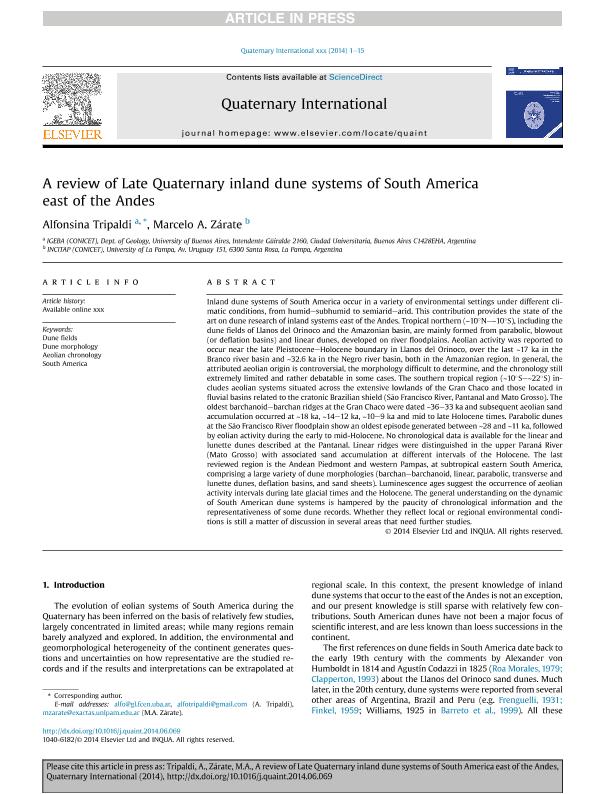Artículo
A review of Late Quaternary inland dune systems of South America east of the Andes
Fecha de publicación:
07/2014
Editorial:
Elsevier
Revista:
Quaternary International
ISSN:
1040-6182
Idioma:
Inglés
Tipo de recurso:
Artículo publicado
Clasificación temática:
Resumen
Inland dune systems of South America occur in a variety of environmental settings under different climatic conditions, from humid–subhumid to semiarid–arid. This contribution provides the state of the art on dune research of inland systems east of the Andes. Tropical northern (∼10°N–∼10°S), including the dune fields of Llanos del Orinoco and the Amazonian basin, are mainly formed from parabolic, blowout (or deflation basins) and linear dunes, developed on river floodplains. Aeolian activity was reported to occur near the late Pleistocene–Holocene boundary in Llanos del Orinoco, over the last ∼17 ka in the Branco river basin and ∼32.6 ka in the Negro river basin, both in the Amazonian region. In general, the attributed aeolian origin is controversial, the morphology difficult to determine, and the chronology still extremely limited and rather debatable in some cases. The southern tropical region (∼10°S–∼22°S) includes aeolian systems situated across the extensive lowlands of the Gran Chaco and those located in fluvial basins related to the cratonic Brazilian shield (São Francisco River, Pantanal and Mato Grosso). The oldest barchanoid–barchan ridges at the Gran Chaco were dated ∼36–33 ka and subsequent aeolian sand accumulation occurred at ∼18 ka, ∼14–12 ka, ∼10–9 ka and mid to late Holocene times. Parabolic dunes at the São Francisco River floodplain show an oldest episode generated between ∼28 and ∼11 ka, followed by eolian activity during the early to mid-Holocene. No chronological data is available for the linear and lunette dunes described at the Pantanal. Linear ridges were distinguished in the upper Paraná River (Mato Grosso) with associated sand accumulation at different intervals of the Holocene. The last reviewed region is the Andean Piedmont and western Pampas, at subtropical eastern South America, comprising a large variety of dune morphologies (barchan–barchanoid, linear, parabolic, transverse and lunette dunes, deflation basins, and sand sheets). Luminescence ages suggest the occurrence of aeolian activity intervals during late glacial times and the Holocene. The general understanding on the dynamic of South American dune systems is hampered by the paucity of chronological information and the representativeness of some dune records. Whether they reflect local or regional environmental conditions is still a matter of discussion in several areas that need further studies.
Palabras clave:
Dune Fields
,
Dune Morphology
,
Aeolian Chronology
,
South America
Archivos asociados
Licencia
Identificadores
Colecciones
Articulos(IGEBA)
Articulos de INSTITUTO DE GEOCIENCIAS BASICAS, APLICADAS Y AMBIENTALES DE BS. AS
Articulos de INSTITUTO DE GEOCIENCIAS BASICAS, APLICADAS Y AMBIENTALES DE BS. AS
Articulos(INCITAP)
Articulos de INST.D/CS D/L/TIERRA Y AMBIENTALES D/L/PAMPA
Articulos de INST.D/CS D/L/TIERRA Y AMBIENTALES D/L/PAMPA
Citación
Tripaldi, Alfonsina; Zárate, Marcelo Arístides; A review of Late Quaternary inland dune systems of South America east of the Andes; Elsevier; Quaternary International; 410; Part B; 7-2014; 96-110
Compartir
Altmétricas




